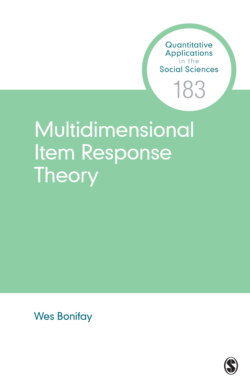Читать книгу Multidimensional Item Response Theory - Wes Bonifay - Страница 7
На сайте Литреса книга снята с продажи.
Series Editor’s Introduction
ОглавлениеIt is my pleasure to introduce Multidimensional Item Response Theory, by Wes Bonifay. Unidimensional item response theory (UIRT) is a statistical framework for the analysis of dichotomous (e.g., correct, incorrect) or polytomous (never, sometimes, always) test items that are assumed to measure a single construct. Multidimensional Item Response Theory (MIRT) extends UIRT to incorporate the possibility that answers to an item or test reflect more than one latent variable or construct. For example, reading ability may affect performance on a test designed to measure proficiency in mathematics. Initially developed in the context of educational testing, applications of MIRT are increasing in other arenas, for example, in the analysis of self-reports to measure anxiety, anger, and depression.
Multidimensional Item Response Theory is one of the more advanced volumes in the QASS Series. It is for readers already well grounded in UIRT and interested in expanding their knowledge and practice to include more complex models. For this group, Professor Bonifay provides an accessible, well explained, logical and carefully worked out introduction to MIRT. Throughout, UIRT serves as a foundation for launching discussions of describing, estimating, and evaluating MIRT models.
After a relatively brief but comprehensive review of UIRT in Chapter 2, Professor Bonifay introduces MIRT models by adding parameters to the UIRT model one at a time. The main focus of Chapter 3 is compensatory MIRT models, where, for example, either of two constructs might lead to a correct answer. Chapter 3 also introduces partially compensatory models, variable compensation models, diagnostic classification models, and, in Chapter 4, MIRT models for polytomous data. Chapter 5 takes up item- and test-level descriptives such as the multidimensional difficulty and discrimination indices; for this chapter, readers might want to brush up on their trigonometry. Chapter 6 discusses item factor structures, including the two-tier model, the testlet model, and the bifactor model. Estimation is the focus of Chapter 7. Multidimensionality complicates the estimation process, and efficient approaches have only been developed recently. In this chapter, Professor Bonifay provides a general overview of MIRT estimation methods (e.g., adaptive quadrature, Bayesian, and Metropolis-Hastings Robbins-Monro approaches), and points interested readers to advanced resources. Diagnostics are addressed in Chapter 8. These include dimensionality assessment, test- and item-level fit assessment, and model comparisons. The final chapter concludes with some applications under development right now.
A hallmark of the volume is the extensive use of graphical displays. These visualizations are essential to the pedagogy as they provide intuition as to the logic underlying various models and procedures. The graphics are helpful in the discussion of UIRT models, for example, illustrating the parameters (discrimination, difficulty, guessing, and inattention) and the consequences of each for the item response functions and information functions. The graphics are critical to the discussion of MIRT models, as here, we are operating in multidimensional space. Professor Bonifay pairs item response surfaces and contour plots in a way that is extraordinarily useful in illustrating the various MIRT models and clarifying differences between them.
In addition to a well-organized introduction to MIRT models, the volume provides several resources that will be helpful to readers. First, Professor Bonifay has created a Companion Student Study Site at study.sagepub.com/researchmethods/qass/bonifay-multidimensional-item-response-theory-1e that illustrates the procedures and applications discussed in the volume. The Companion Student Study Site leverages a second resource, a freely available irtDemo package developed by Professor Bonifay and a collaborator for the R statistical software environment (Bulus & Bonifay, 2016). Between the two, readers will be able to replicate most of the visualizations in the volume as well as some that cannot be rendered in print, such as the animation of a 360-degree rotating 3-dimensional response surface! Third, the text points to published examples that illustrate the kinds of models and issues discussed in the text. Fourth, basic R programming syntax is included throughout the text to enable readers to conduct their own MIRT analyses. As mentioned, this is an advanced text, but for readers with the appropriate background, it pulls together, organizes, presents the technical literature in an accessible way, and, in doing so, will increase the use of MIRT models in social science generally as well as in educational psychology and evaluation.
—Barbara Entwisle
Series Editor
